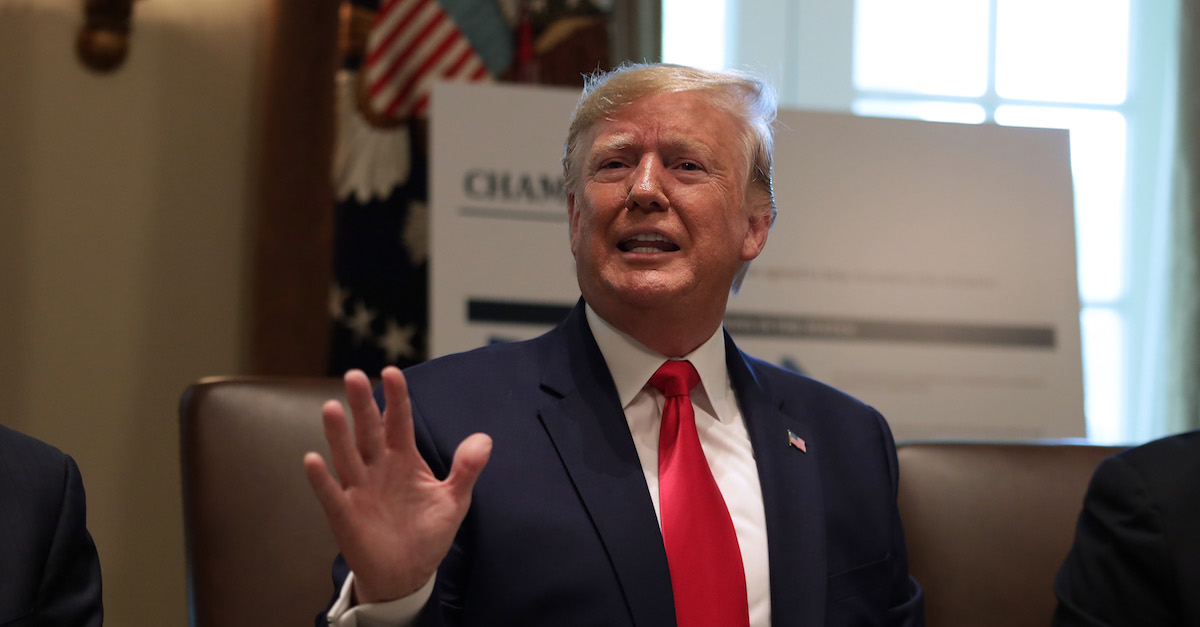
It’s been a blockbuster week at the Supreme Court of the United States. Unfortunately for the Trump administration, it’s been a week filled with setbacks on multiple fronts. In a 5-4 decision on Thursday, the Supreme Court ruled that the Trump administration, when attempting to rescind then-President Barack Obama’s Deferred Action for Childhood Arrivals program (DACA) in 2017, ran afoul of administrative law. Lawyers were quick to point out that this was not the first time that SCOTUS has ruled against “arbitrary and capricious” Trump administration actions.
The Supreme Court opinion, penned by Chief Justice John Roberts, held that the Department of Homeland Security’s rationale for rescinding DACA was “arbitrary and capricious” under the Administrative Procedure Act (APA).
RELATED: Supreme Court Rules Trump Administration Violated the Law When Trying to End DACA
“The APA’s arbitrary-and-capricious standard requires that agency action be reasonable and reasonably explained. As the Court has long stated, judicial review under that standard is deferential to the agency. The Court may not substitute its policy judgment for that of the agency. The Court simply ensures that the agency has acted within a broad zone of reasonableness and, in particular, has reasonably considered the relevant issues and reasonably explained the decision,” the opinion said. “The Executive Branch explained its decision to rescind DACA in two sequential memorandums by successive Secretaries of Homeland Security: the 2017 Duke Memorandum and the 2018 Nielsen Memorandum. The Duke Memorandum focused on DACA’s perceived legal flaws. The Court today finds the Duke Memorandum insufficient under the APA’s arbitrary-and-capricious standard.”
The high court explained that administrative law values “promot[e] agency accountability to the public”:
The rule requiring a new decision before considering new reasons is not merely a formality. It serves important administrative law values by promoting agency accountability to the public, instilling confidence that the reasons given are not simply convenient litigating positions, and facilitating orderly review. Each of these values would be markedly undermined if this Court allowed DHS to rely on reasons offered nine months after the rescission and after three different courts had identified flaws in the original explanation.
Chief Justice Roberts, you may recall, also wrote the opinion when ruling 5-4 against the administration on the issue of adding a citizenship question to the 2020 Census. In that case, the Supreme Court determined that the administration’s stated rationale for adding the question did not match up with the evidence–in violation of the APA:
the evidence tells a story that does not match the [Commerce] Secretary’s explanation for his decision. Unlike a typical case in which an agency may have both stated and unstated reasons for a decision, here the VRA [Voting Rights Act] enforcement rationale—the sole stated reason—seems to have been contrived. The reasoned explanation requirement of administrative law is meant to ensure that agencies offer genuine justifications for important decisions, reasons that can be scrutinized by courts and the interested public. The explanation provided here was more of a distraction. In these unusual circumstances, the District Court was warranted in remanding to the agency.
Since that ruling, we have only learned more about the administration’s underlying motives for adding the question.
The Trump administration has repeatedly been tripped up in court by administrative law shortcomings (see: here, here, here, and here). Legal experts have clearly noticed.
“It’s not that Chief Justice Roberts is a closet progressive. He’s not. It’s that the Trump administration is *really bad* at administrative law,” University of Texas law Prof. Steven Vladeck said.
https://twitter.com/LeahLitman/status/1273634865183940609?s=20
“’But the APA doesn’t care [about the Presidents feelings],’” University of Michigan law Prof. Leah Litman quipped in response to a complaint from President Donald Trump.
“It’s not about you, it’s about your silly arguments. The Court doesn’t like those. End of story,” Supreme court litigator Neal Katyal added.
Professor of Law and Political Science at UC Irvine Rick Hasen said the real story here is that the Trump administration was called out for hiding the truth about its policies.
“Alternative take: it wasn’t the sloppiness so much as the fact that the government offered pretexts for its decisions rather than owning them outright. It is a good story then about enforcement of a norm of government honesty in decisionmaking,” he said.
CNN chief legal analyst Jeffrey Toobin, however, is of the opinion that Dreamers shouldn’t rest on their laurels. According to Toobin, the real-world impact of the decision is that Chief Justice Roberts, through his opinion, has provided a roadmap to procedural success by exposing the Trump administration’s failure on procedural grounds.
Toobin argued that DACA, among other things, will be on the ballot in November.
Former Obama administration lawyer Eric Columbus concurred with this take.
“Key point: SCOTUS didn’t say Trump *can’t* rescind DACA, just that he didn’t do it the right way. If Trump wins reelection he can try it again — and might succeed,” Columbus said.
In the census case, it was also true that the high court didn’t say the Trump administration couldn’t add a citizenship question to the census. The court said the Commerce Department had to go back to the drawing board and come up with a rationale that didn’t violate the APA. The administration ultimately opted not to do that due to time constraints.
[Image via Alex Wong/Getty Images]